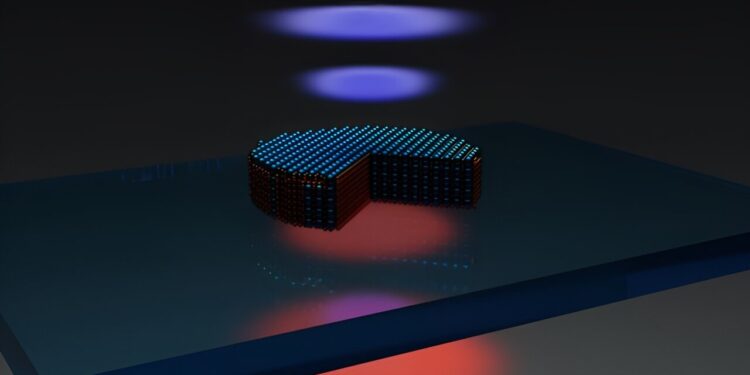Schematic of the optical experiment: Near-infrared laser excitation (bottom, red): excites the nanodisk made from the 3R molybdenum disulfide sheet, placed on a glass substrate. The quarter-cut section of the disk schematically shows that the incident laser excites optical resonances, which is why we see red areas, which represent a higher density of the electromagnetic field. This localization, together with the broken inverse symmetry of the crystal lattice, allows for efficient conversion of the red pump laser into blue light (doubled frequency). Credit: Chalmers University of Technology
Photonic applications harness the power of light-matter interactions to generate a variety of fascinating phenomena. This has enabled major advances in communications, medicine, and spectroscopy, among others, and is also used in laser and quantum technologies.
Now, researchers from the Department of Physics at Chalmers University of Technology have succeeded in combining two major research areas – nonlinear and high-index nanophotonics – in a single disc-shaped nanoobject.
“We were amazed and pleased with what we managed to achieve. The disk-shaped structure is much smaller than the wavelength of light, but it is a very efficient converter of light frequency. It is also 10,000 times or more more efficient than the unstructured material of the same type, which proves that nanostructuring is the way to improve efficiency,” says Dr. Georgii Zograf, lead author of the paper published in Photonics of nature where the search results are presented.
New manufacturing without loss of properties
To simplify, the researchers combined in the nanodisk a combination of material and optical resonances with the ability to convert light frequency thanks to the nonlinearity of a crystal. For its fabrication, they used transition metal dichalcogenide (TMD), namely molybdenum disulfide, an atomically thin material that has exceptional optical properties at room temperature. The problem with this material, however, is that it is very difficult to stack it without losing its nonlinear properties due to its crystal lattice symmetry constraints.
“We have fabricated for the first time a specifically stacked molybdenum disulfide nanodisk that preserves the broken inverse symmetry in its volume and therefore maintains the optical nonlinearity. Such a nanodisk can preserve the nonlinear optical properties of each layer. This means that the material effects are both maintained and enhanced,” Zograf explains.
The material has a high refractive index, meaning that light can be squeezed more efficiently in this medium. In addition, the material has the advantage of being transferable to any substrate without the need to match the atomic lattice with the underlying material.
The nanoscale structure is also very effective in localizing the electromagnetic field and generating frequency-doubled light, an effect called second harmonic generation. This is a so-called nonlinear optical phenomenon, similar for example to the sum-and-difference frequency generation effects used in high-energy pulsed laser systems.
Thus, this nanodisk combines extreme nonlinearity with a high refractive index in a single, compact structure.
A big step forward for optics research
“The material and design we propose are state-of-the-art due to extremely high inherent nonlinear optical properties and remarkable linear optical properties, with a refractive index of 4.5 in the visible optical range. These two properties make our research so novel and potentially attractive even for industry,” says Zograf.
“This is a really important milestone, especially because of the extremely small size of the disk. Second harmonic generation and other nonlinearities are used daily in lasers, but the platforms that use them are typically on the centimeter scale. In contrast, the scale of our object is about 50 nanometers, which is about 100,000 times thinner,” explains Professor Timur Shegai, who led the research.
The researchers believe that the work on the nanodisk will advance photonics research. In the long term, the incredibly compact dimensions of TMD materials, combined with their unique properties, could potentially be used in advanced optical and photonic applications. For example, these structures could be integrated into various types of optical circuits or used in the miniaturization of photonics.
“We believe that this material can contribute to future nonlinear nanophotonics experiments of various types, both quantum and classical. By having the ability to nanostructure this unique material, we could significantly reduce the size and improve the efficiency of optical devices, such as nanodisk arrays and metasurfaces.
“These innovations could be used in applications in nonlinear optics and in the generation of entangled photon pairs. This is a first step, tiny, but very important. We are only at the beginning,” says Shegai.
More information:
George Zograf et al., Combining ultrahigh index with exceptional nonlinearity in resonant transition metal dichalcogenide nanodisks, Photonics of nature (2024). DOI: 10.1038/s41566-024-01444-9
Provided by Chalmers University of Technology
Quote:Unique nanodisk advances photonics research (September 11, 2024) retrieved September 11, 2024 from
This document is subject to copyright. Apart from any fair dealing for the purpose of private study or research, no part may be reproduced without written permission. The content is provided for informational purposes only.



